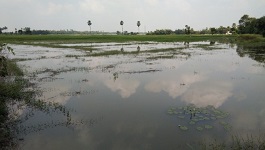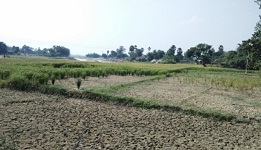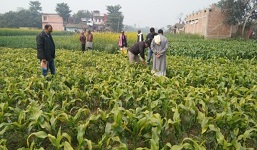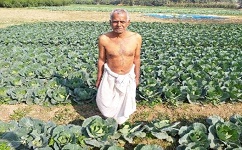Flood being a natural disaster emerges as a severe challenge to the global agriculture and poses a threat to the food security. Bihar and Odisha account for about 12.7% and 4.2% of the total flood prone area of the country (40 Million / ha), respectively. Muzaffarpur and East Champaran Districts of Bihar and Puri District of Odisha are extremely susceptible to the floods due to the extreme climatic rainfall events, poor drainage and breaching of river embankment. The flood water remains in the agricultural fields for 6 to 15 days causing severe damage to the Kharif crops, mainly rice.






The ICAR-Indian Institute of Water Management, Bhubaneswar in collaboration with ICAR Research Complex for Eastern Region, Patna and International Water Management Institute (IWMI), Colombo initiated a research study in the Year - 2017 on “Enhancing agriculture resilience in flood-prone areas of Bihar and Odisha through post-flood crop management and index based flood insurance (IBFI)” for developing the flood resilient agricultural practices and adaptation measures. The initiative also aims at developing a technological support base for the Pradhan Mantri Fasal Bima Yojana (PMFBY) in terms of enhancing the quality of assessment of extent and duration of flood water in the agricultural fields.
Initially, the Institute analyzed the flood frequency and extent in these Districts to identify the most severely flood affected areas and devise the post-flood management strategies for the different scenarios (Brahmanand et al., 2017; http://www.iiwm.res.in/publication.php). The stage-wise crop damage in Gaighat Block of Muzaffarpur District of Bihar was assessed in terms of both flood duration and extent and the index-based crop insurance ranging from Rs.7000/- per ha to Rs.20,000/- per ha was paid to 43 and 170 farmers during the Years - 2017 and 2018, respectively.
ICAR and IWMI prepared and implemented the post-flood crop management plan based on the crop damage in the operational area, that is, the flood affected areas of 2 Blocks of Bihar namely Gaighat (Muzaffarpur District), Chiraiya (East Champaran District) and 1 Block of Odisha - Kanhas (Puri District) during the last 2 years.
Flood affected farmers of Bihar were provided with the seeds of alternate crops, that is, hybrid maize, lentil, mustard, brinjal, tomato, cucumber, cabbage and cauliflower as per the post-flood crop management plan. The seeds were then sown / planted at the optimum time under the post flood environment. The farmers could generate additional net returns of about Rs.16,700/- per ha due to the timely sowing of alternate crops like maize compared to the flood damaged field without intervention. The net returns of the farmers were also enhanced up to range of Rs. 33,200 to Rs. 37,700 per ha due to the cultivation of vegetables like tomato, brinjal, cabbage, cucumber and cauliflower under the post-flood environment.
The intervention of over-aged rice seedlings (60 days) resulted in the higher grain yield by 24% (4.35 t ha-1) and 29% (4.51 t ha-1) during the Years - 2018 and 2019, respectively as compared to the mean grain yield of normal transplanted (30 days old) rice seedlings (3.5 t ha-1) in the flood-prone areas of Kanas Block, Puri District of Odisha.
Farmers were also encouraged to cultivate the mango saplings in the agricultural fields for better cushioning during the flood event. Overall, the post-flood management interventions resulted in the enhancement of the benefit:cost ratio from 1.55 to 3.08 and have potential to enhance the agricultural resilience in chronologically flood-prone areas of the country.
(Source: ICAR-Indian Institute of Water management, Bhubaneswar)







फेसबुक पर लाइक करें
यूट्यूब पर सदस्यता लें
X पर फॉलो करना X
इंस्टाग्राम पर लाइक करें